Go Behind the Bottle with 7 Ohio Winemakers
Meet families across Ohio’s seven distinct wine regions that are working to put our state’s wine scene on the map.
March/April 2025
BY Rich Warren | Rhonemus Cellars in Lancaster, photo by Kevin Kopanski
March/April 2025
BY Rich Warren | Rhonemus Cellars in Lancaster, photo by Kevin Kopanski
Ohio is blessed with nearly 430 licensed wineries in every corner of the state, scattered across seven distinctive regions. Behind each one of those wineries, there’s a compelling story, oftentimes of an individual who’s pursued a passion for winemaking and has followed his or her dream to start their own business. In other cases, the operation of a winery is a family affair, with several individuals pitching in together to ensure the success of their winery or aspiring to pass their family business to the next generation.
On Course
Just opened in November 2024 in Lancaster, Rhonemus Cellars has quickly become a destination for wine lovers. Soaring plate glass windows and spacious outdoor decks and patios overlook a lake and golf course. Proprietors Barry and Jennifer Rhonemus prefer to call their new facility a visitors center since it also incorporates a fine dining restaurant and lounge, in addition to the winery and tasting room.
Barry and Jennifer were high school sweethearts who reunited 13 years ago. When they decided to return to their hometown, they learned that the Valley View Golf Club — a Lancaster fixture for more than six decades — was for sale, and they decided to purchase it. Inspired by visits to wine regions in Virginia and California, they decided to establish a winery and incorporate it into The View Golf Club. Currently using fruit from California and New York’s Finger Lakes, Rhonemus Cellars’ wine offerings will eventually be supplemented by grapes from 2,200 vines planted on the property in 2024, with 1,800 more planned in 2025.
To achieve their vision, the Rhonemuses have surrounded themselves with experts. Their principal winemaker, Nova Cadamatre, is one of only 58 Masters of Wine in the U.S. and the first female to achieve that distinction. She’s assisted by resident winemaker Nico Felice, with formal education in enology, and vineyard manager Kenzie Salyers. Executive Chef Nic Lombardo has more than 20 years’ experience in the culinary industry.
The family’s three children — daughter Morgan Carpenter and husband George, son Connor Smith and wife Olivia, and son Drew Smith and wife Ruth — also offer substantial support to the business, including the arduous task of planting the winery’s first vines. Even their five grandchildren were enlisted for help with this work. “We paid each of them a nickel for every rock and golf club they pulled out of the soil,” Barry says.
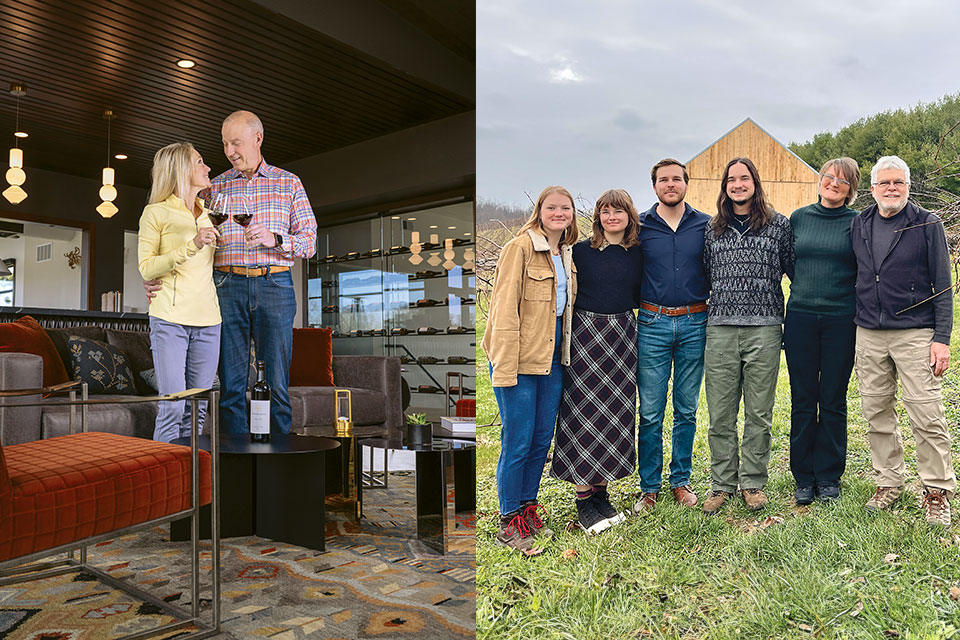
Left: Jennifer and Barry Rhonemus of Lancaster’s Rhonemus Cellars enjoy a glass of wine. (photo by Wendy Pramik) Right: The Chevalier family of Creola’s Le Petit Chevalier Vineyards and Farm Winery pose for a group photo. (photo courtesy of Le Petit Chevalier Vineyards and Farm Winery)
Off the Beaten Path
Mark and Margit Chevalier, owners of Le Petit Chevalier Vineyards and Farm Winery in Creola, like to say their winery is “conveniently located in the middle of nowhere.” But what a picturesque corner of nowhere it is. The hilltop location offers an astounding vista of rolling forested hills as far as the eye can see, not to mention the winery’s eight acres of vines where the Chevaliers allow their flock of Southdown sheep to graze. Guests are encouraged to stroll the vineyards, glass in hand, often accompanied by a friendly border collie named Alexander.
In addition to the scenery, the Chevaliers offer multitudes of reasons for their guests to make the four-mile detour off St. Rte. 56. The wine itself is of course a powerful draw, a suite of entirely estate-grown native heirloom and cold-hardy hybrids. As they’ll happily tell you, “If you find a wine you really like, you can go out and hug the vines that produced it.” Guests can enjoy their wines in a rustic tasting room or on outdoor porches and decks.
Those so inclined to linger longer can stay overnight, either in a spacious loft just above the tasting room or in the brand-new Winery Cottage, a two-bedroom, ADA-accessible structure tucked between the vineyards and a pond. Hiking is available in the adjacent Bison Hill State Nature Preserve, complete with a sandstone gorge with rock outcrops and waterfalls.
The Chevaliers raised their four children in the 1880 farmhouse located on the property. Their older son Andreas works at the winery on weekends, while their daughter Clarissa helps with marketing and social media. The two younger children, Lilly and Adrian, also assist in the family enterprise when they visit from their homes in Columbus and Oregon. “We really feel like we’ve put our roots down deep here,” Margit explains. “Our children feel the same way.”
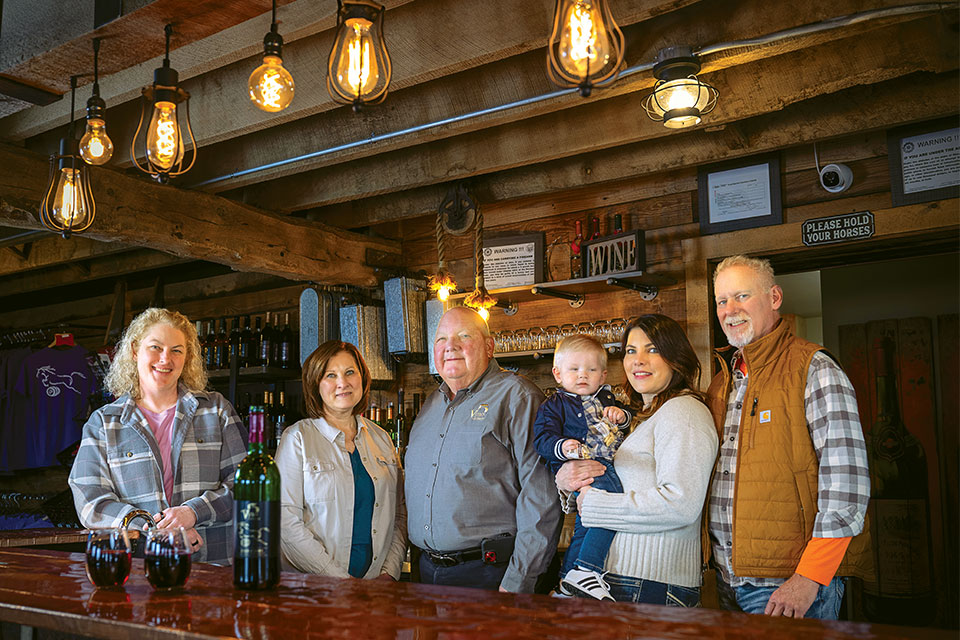
The Krieg family of Wapakoneta’s Five Vines Winery stands behind the bar. (photo by Wendy Pramik)
Tied Up in Vines
The family ties associated with Five Vines Winery, located outside of Wapakoneta, are embedded within the name of the business. In 2011, Don and Dottie Krieg’s daughter, Becky, brought home five grapevines from a trip she’d made to upstate New York. The Kriegs planted those vines and have never stopped planting — currently they’re up to 2,500 vines on just under three acres.
The Kriegs began by selling their grapes to other producers, but in 2018 decided that starting their own winery would be a good idea. They transformed an old barn that stood adjacent to their 1880 farmhouse where their daughters had once raised horses as a 4-H project. Today, the horses and their stalls are long gone, but the rustic feel remains with the barn’s original beams still in place, as well as a beautiful bar with striking copper flashing. The winery’s origins are depicted in Five Vines’ logo, a horse leaping over a wine barrel.
Currently, Dottie and the Kriegs’ other daughter, Stacey Brackney, serve as Five Vines’ winemakers. Brackney learned the craft by taking oenology courses online and by serving an internship with the late Jim Brandeberry of Brandeberry Winery.
“He was so incredibly patient and had such a wide breadth of knowledge,” Brackney recalls. The mother and daughter use the French hybrid vines just outside the winery to produce wines such as Vidal Blanc, Traminette, Chambourcin, and Frontenac wines.
Don takes care of everything in the vineyard, from pruning to harvesting, while Brackney’s husband, Dan, works behind the bar on weekends and helps with bottling and harvesting.
“As a family, we seem to work well together without much tussle, and in fact, working side by side every day has brought us even closer,” Dottie says.
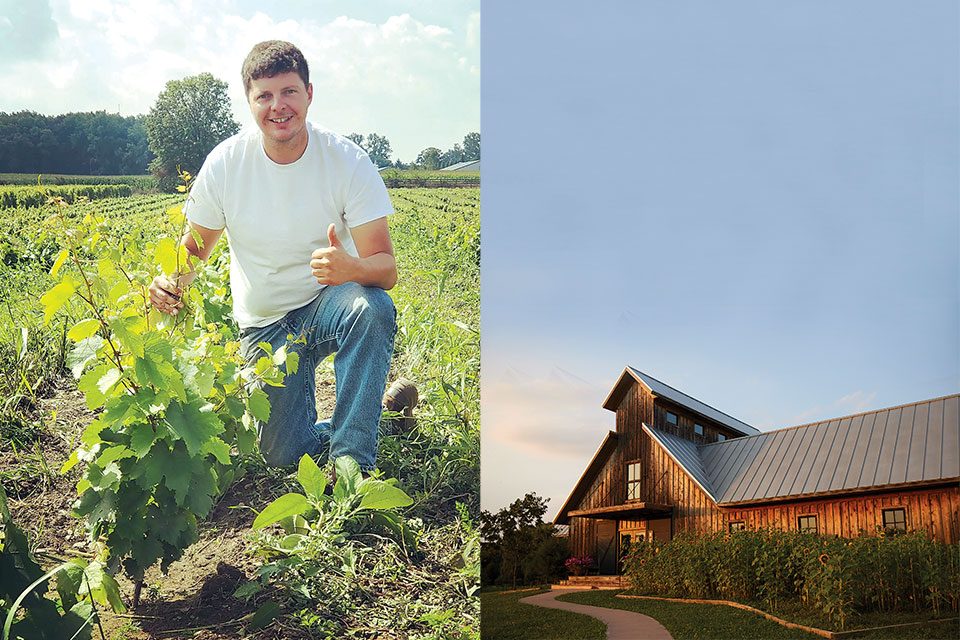
Left: Joe Juniper of Wakeman’s Vermillion Valley Vineyards tends the grapevines. (photo courtesy of Joe Juniper) Right: Head to the rustic tasting room, designed to resemble a barn. (photo by Kevin Kopanski)
Grape Farmers
Tending vineyards has been a life-time passion for Joe Juniper of Vermilion Valley Vineyards near Wakeman.
Joe, the former president of the Ohio Wine Producers Association and a native of Sandusky, started working at a winery at age 13, getting hands-on experience in the vineyards about how what happens to the grapes during the growing season impacts what ends up in the glass and bottles of wine. He looks after the vineyards and assists in the making of wine at Vermilion Valley Vineyards, but insists that it’s his wife Kristi who has the superior palate.
The bulk of what they grow is European-style vinifera grapes like Pinot Noir, Cabernet Franc, and Riesling. Juniper explains that the winery’s position near the southernmost part of Lake Erie protects it from the harsh lake effect snows and temperatures.
The Junipers have created a scenic destination at Vermilion Valley Vineyards. The tasting room and production facility were built to resemble an old tobacco barn, complete with a peaked roof resembling a cupola. Although it appears quite old, it was constructed in 2009.
Juniper says that another thing that distinguishes their business is an emphasis on sustainability — the structure at Vermilion Valley Vineyards, for example, is LEED-certified and they use a special sprayer that recaptures overspray.
“Our name, Vermilion Valley Vineyards, is a reminder that every agricultural practice we undergo in the vineyards has an impact on the Vermilion River watershed and on Lake Erie,” Juniper says. “I like to think of ourselves primarily as grape farmers who place an emphasis on environmental sustainability.”
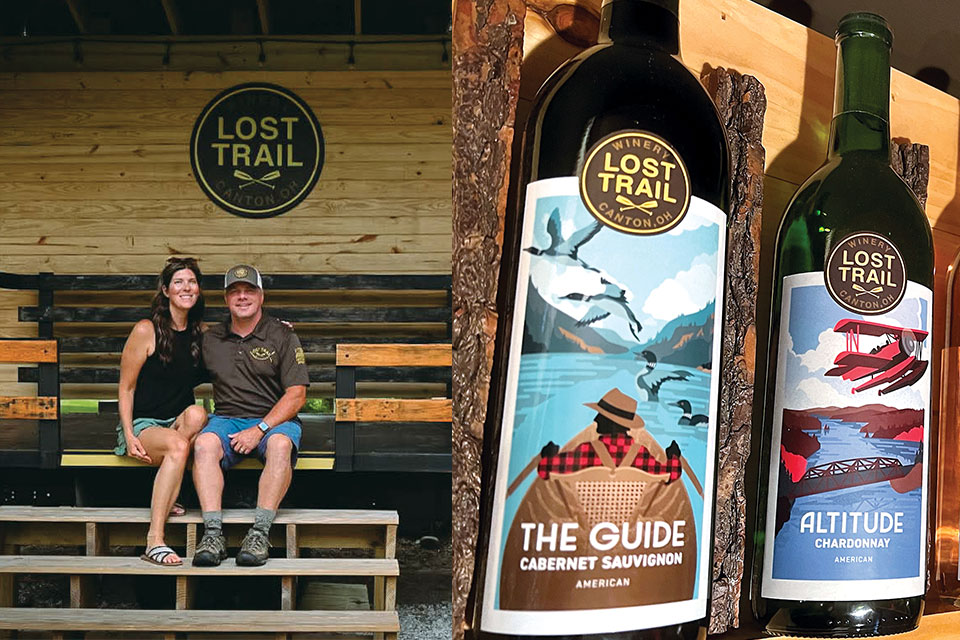
Left: Kim and Chris Rohr of Stark County’s Lost Trail Winery and Vineyard pose for a photo. (photo courtesy of Lost Trail Winery and Vineyard) Right: Enjoy Adirondack-themed wines from the Canton destination. (photo courtesy of Lost Trail Winery)
Trail Mix
When Chris and Kim Rohr purchased vacant land in Stark County’s Marlboro Township just outside of Canton, they envisioned using the property as a place where people could meet and relax in a wooded setting. They opened Lost Trail Winery and Vineyard, which combines their deep love for nature and good wines.
The family is fond of the Adirondack Mountains in upstate New York, a frequent hiking destination on family trips and a place with a strong family history. The labels on their bottles feature Adirondack scenery, and even the names have significance, like “Kienuka,” which is the name for Kim’s family’s Adirondack Camp on Tupper Lake.
The tasting room patio offers views of the nearby five-acre pond and wildlife. Fruit trees grow throughout the property, including apples, pears, and peaches. The Rohrs plan to incorporate them in fruit wines.
Chris is the primary winemaker at Lost Trail, but Kim and their four young sons, ranging in age from two to 12, are also involved in the family enterprise, assisting in harvesting the grapes and in bottling and corking the wine. Chris stresses that the family atmosphere also extends to the winery’s visitors. “When we connect with our guests, they become like family to us,” he says.
Chris also honors his former military service in the U.S. Marine Corps. They have wine sleeves designed to look like military flak jackets — a great gift for veterans.
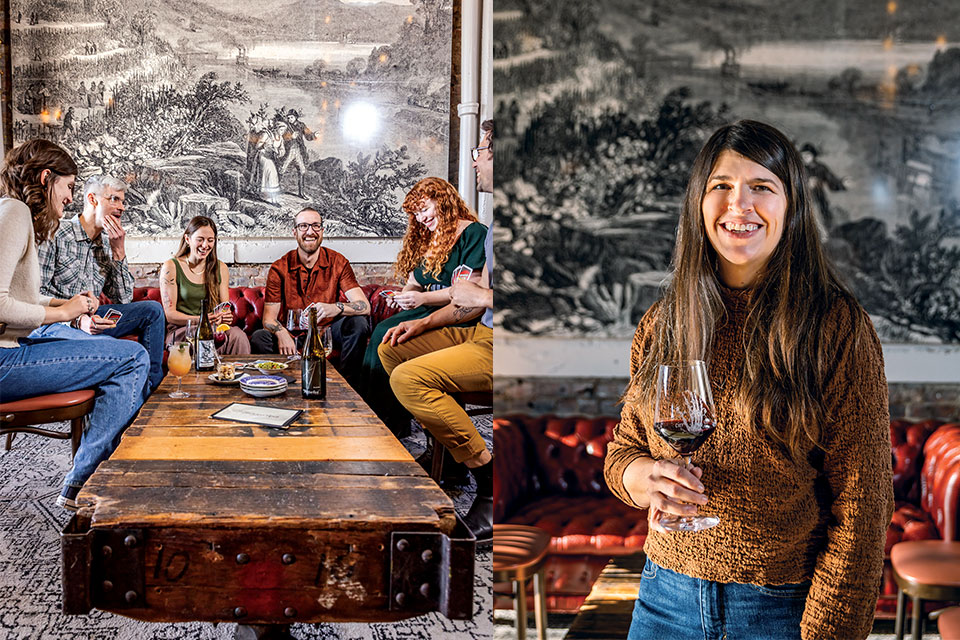
Left: Friends play a card game at Cincinnati’s The Skeleton Root. (photo by Matthew Allen) Right: Kate MacDonald returned home to Cincinnati to open her winery. (photo by Matthew Allen)
Rooted in Ohio
Kate MacDonald, owner and proprietor of The Skeleton Root in Cincinnati’s trendy Over-The-Rhine neighborhood, will tell you she wants her wine to be an expression of a place, “particularly of this place,” she emphasized. She’s passionate about using grapes that have historic roots in the Ohio River Valley clear back to the mid-19th century, when Nicholas Longworth turned the region into the wine capital of the entire country, the Napa Valley of its day. MacDonald uses native American grapes like Catawba, Norton, Delaware, and Isabella, as well as other varietals like Riesling, Sauvignon Blanc, and Vidal Blanc, to produce dry wines distinctively different from the sweet wines those grapes often are used to make.
MacDonald’s journey into winemaking was a long one. She began her career as an aviation engineer, her work sending her away from her native Cincinnati to places like northeast Pennsylvania, where she was within easy reach of New York’s Finger Lakes wine region. It was there she says she had her first “Aha!” moment and found herself falling in love with wine. When she returned to Cincinnati, she started engaging with other Ohio winemakers, particularly with Greg Pollman, now retired from Valley Vineyards.
She pursued studies in oenology and eventually transitioned to California to immerse herself in the wine industry there, experimenting with new wine styles. She developed a passion for cool climate vines, which drew her back to Cincinnati, where she could develop relationships with Ohio grape growers to begin producing the distinctive dry wines The Skeleton Root is now known for. As MacDonald says, “it was wine that brought me home.”
MacDonald’s partner, Josh Jackson, was by her side every step of the way. In 2016, she opened The Skeleton Root in an old warehouse in a light and airy loft area complete with couches and armchairs arranged as though they were in someone’s living room. There’s even a mural dating back to Nicholas Longworth’s day depicting terraced vineyards overlooking the Ohio River.
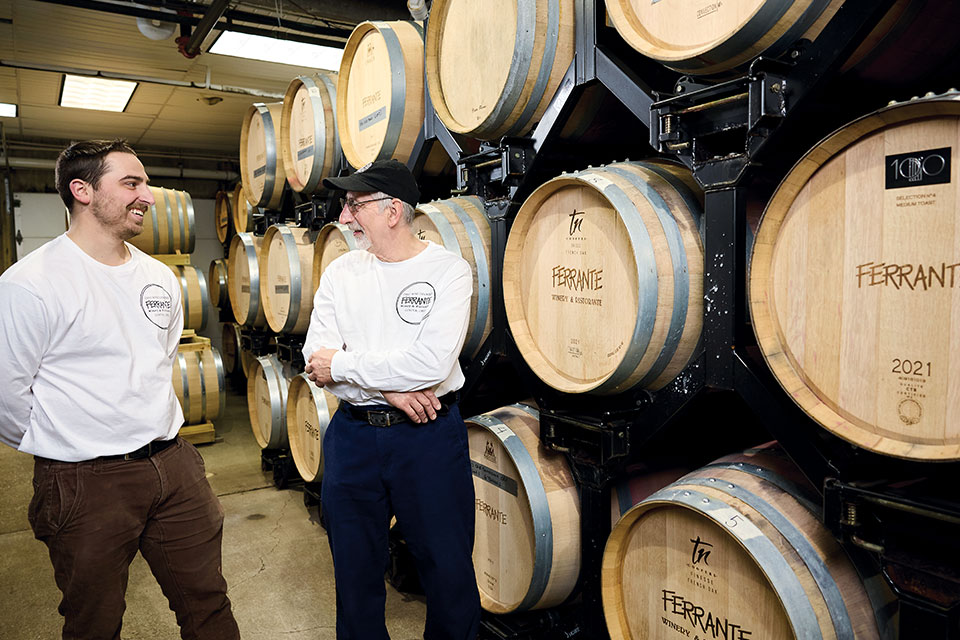
Cleveland’s Ferrante Winery & Ristorante is a multigenerational business. (photo by Kevin Kopanski)
Family Business
Few wineries in Ohio have the storied family history that Ferrante Winery & Ristorante does. In 1937, Italian immigrants Nicholas and Anna Ferrante opened a winery in Cleveland’s Collinwood neighborhood using grapes from a family vineyard in Geneva. In the 1970s, their son Peter moved the business out to this site and built a winery and tasting room. That structure burned in the 1990s but was replaced by the larger facility standing today, which includes an Italian restaurant overlooking the vineyard that draws almost as many visitors as the winery itself.
Today, five of Peter’s children are still integrally involved in the family business. Managing the winery’s extensive 40-acre vineyard is Anthony Ferrante, while his brother, Nick, serves as chief winemaker. Sisters Carmel and Mary Jo work in the restaurant, while another sister, Lisa, keeps the company’s books.
And now, more than 80 years after the winery’s founding, a member of the family’s fourth generation has joined the business. Dominick Ferrante, a 2021 graduate of Ohio University with a degree in chemistry, has taken on the job of assistant winemaker. “Winemaking is all about chemistry,” Dominick says. “In the winery, we’re constantly checking the wines’ pH and acidity levels. Even outside, it’s the chemistry in the soil itself and the minerals in it that give the grapes what they need to grow.”
Dominick supplemented his formal education by earning a winemaking certificate from Cornell University.
A lifetime of exposure to the family’s wine business has also given him a leg up, not to mention working side by side with his Uncle Nick, who’s been making wine for 40 years. “I’m proud to be a part of a family business that goes back to 1937,” he says.
Sip Magazine is for Ohio wine lovers and is produced by Great Lakes Studios in partnership with the Ohio Grape Industries Committee. View a digital version of Sip Magazine 2025 here.
Related Articles

How Ohio’s Vineyard Expansion Assistance Program is Growing the Industry
The grants encourage new and existing Ohio vineyards to invest in planting high-quality vines instead of buying grapes from other states. READ MORE >>

An Ohio Winery for Every Season
From shaded patio sips on a hot summer day to cozy fireside toasts on a snowy night, our state’s variety of wineries can help you soak up the spirit of every season. READ MORE >>

Raise a Glass to a Good Cause at 3 Ohio Wineries
When you support a local business, the impact radiates into the surrounding community. That’s especially true at these wineries that pair wine with philanthropy. READ MORE >>



